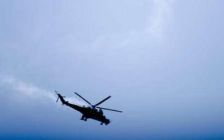Fighting in Somali capital rages for third day
March 31, 2007 (MOGADISHU) — Fighting raged for a third day in the Somali capital Saturday as government troops and their Ethiopian allies continued a major offensive to quash a growing insurgency by Islamic militants.
 Artillery fire and mortar shells rained down on the capital, sending residents fleeing some of the heaviest fighting in Mogadishu since the early 1990s.
Artillery fire and mortar shells rained down on the capital, sending residents fleeing some of the heaviest fighting in Mogadishu since the early 1990s.
On Friday, insurgents shot an Ethiopian helicopter gunship out of the sky and mortar shells slammed into a hospital, leaving corpses piled in the streets and wounding hundreds of civilians.
According to an official count, 30 people have been killed since the offensive started Thursday. But the fighting was so severe and widespread in Mogadishu that bodies were not being picked up or even tallied, and residents said hundreds more were believed dead across the city of 1 million people.
The insurgents are linked to the Council of Islamic Courts, which was driven from power in December by Somali and Ethiopian soldiers, accompanied by U.S. special forces.
Insurgents were firing mortars from residential areas of the city, and Ethiopian troops responded with barrages of heavy artillery. The attacks occurred across the flat seaside capital, and huge plumes of smoke rose into the air.
The International Committee of the Red Cross said dozens of people have been killed since Thursday and more than 220 wounded, most of them civilians with bullet, grenade and other shrapnel wounds.
“The population of Mogadishu is caught up in the worst fighting in more than 15 years,” the agency said.
The U.N.’s refugee agency said 58,000 people have fled violence in the Somali capital since the beginning of February.
Islamic militants – who now dominate the insurgency – stockpiled thousands of tons of weapons and ammunition during the six months they controlled Mogadishu. The insurgency will likely last until that stockpile is depleted, or key leaders are killed.
The militants have long rejected any secular government and have sworn to fight until Somalia becomes an Islamic emirate. Clan elders have tried to negotiate several cease-fires, but cannot control the young insurgents.
On Friday, an Associated Press reporter saw an anti-aircraft missile hit an Ethiopian helicopter that had been bombing insurgent positions.
Somalia has been mired in chaos since 1991, when warlords overthrew dictator Mohamed Siad Barre and then turned on one another.
A U.N. peacekeeping operation in the 1990s saw clashes between foreign troops and Somali fighters, including the notorious downings of two U.S. Black Hawk helicopters in 1993 – which was followed by a firefight that killed some 300 Somalis in 12 hours. The U.S. withdrew from Somalia in 1994, and that was followed a year later by the departure of U.N. peacekeepers.
A national government was established in 2004 but has failed to assert any real control. The administration, with crucial support from Ethiopian troops, toppled the Council of Islamic Courts in December, but insurgents with links to the group have staged attacks nearly every day.
The U.S. has accused the Islamic courts of having ties to al-Qaida.
(AP)
